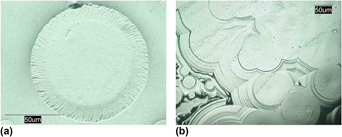Crossref Citations
This article has been cited by the following publications. This list is generated based on data provided by
Crossref.
Wellen, Renate M.R.
and
Canedo, Eduardo L.
2016.
Nonisothermal melt and cold crystallization kinetics of poly(3-hydroxybutyrate) and poly(3-hydroxybutyrate)/carbon black compounds. Evaluation of Pseudo-Avrami, Ozawa, and Mo models.
Journal of Materials Research,
Vol. 31,
Issue. 6,
p.
729.
Ries, Andreas
Canedo, Eduardo L.
Souto, Cícero R.
and
Wellen, Renate M.R.
2016.
Non-isothermal cold crystallization kinetics of poly(3-hydoxybutyrate) filled with zinc oxide.
Thermochimica Acta,
Vol. 637,
Issue. ,
p.
74.
Wellen, Renate Maria Ramos
Canedo, Eduardo Luís
Rabello, Marcelo Silveira
and
Fechine, Guilhermino José Macêdo
2016.
Photodegradation and Photostabilization of Poly(3-Hydroxybutyrate).
Materials Research,
Vol. 19,
Issue. 4,
p.
759.
Ries, Andreas
Canedo, Eduardo L.
Monteiro, Alceu E.G.
de Almeida, Yêda M.B.
and
Wellen, Renate M.R.
2016.
Model-free non-isothermal crystallization kinetics of poly(3-hydoxybutyrate) filled with carbon black.
Polymer Testing,
Vol. 50,
Issue. ,
p.
241.
Jaques, Nichollas Guimarães
Silva, Ingridy Dayane dos Santos
Barbosa Neto, Manoel da Cruz
Diniz, Rayane Karoline Melo
Wellen, Renate Maria Ramos
and
Canedo, Eduardo Luis
2017.
Comparative study of the effect of TiO2 and ZnO on the crystallization of PHB.
Matéria (Rio de Janeiro),
Vol. 22,
Issue. 4,
Almeida, Tatiara G.
Costa, Anna Raffaela M.
Wellen, Renate M. R.
Canedo, Eduardo L.
and
Carvalho, Laura H.
2017.
PHB/Bentonite Compounds. Effect of Clay Modification and Thermal Aging on Properties.
Materials Research,
Vol. 20,
Issue. 6,
p.
1503.
Bezerra, Elieber Barros
França, Danyelle Campos
Morais, Dayanne Diniz de Souza
Rosa, Morsyleide de Freitas
Morais, João Paulo Saraiva
Araújo, Edcleide Maria
and
Wellen, Renate Maria Ramos
2017.
Processing and Properties of PCL/Cotton Linter Compounds.
Materials Research,
Vol. 20,
Issue. 2,
p.
317.
Beber, Vinicius
De Barros, Silvio
Banea, Mariana
Brede, Markus
De Carvalho, Laura
Hoffmann, Ron
Costa, Anna
Bezerra, Elieber
Silva, Ingridy
Haag, Katharina
Koschek, Katharina
and
Wellen, Renate
2018.
Effect of Babassu Natural Filler on PBAT/PHB Biodegradable Blends: An Investigation of Thermal, Mechanical, and Morphological Behavior.
Materials,
Vol. 11,
Issue. 5,
p.
820.
Jaques, Nichollas Guimarães
Silva, Ingridy Dayane dos Santos
Barbosa Neto, Manoel da Cruz
Ries, Andreas
Canedo, Eduardo Luis
and
Wellen, Renate Maria Ramos
2018.
Effect of heat cycling on melting and crystallization of PHB/TiO2 compounds.
Polímeros,
Vol. 28,
Issue. 2,
p.
161.
dos Santos Silva, Ingridy Dayane
Guimarães Jaques, Nichollas
da Cruz Barbosa Neto, Manoel
Agrawal, Pankaj
Ries, Andreas
Ramos Wellen, Renate Maria
and
Canedo, Eduardo Luis
2018.
Melting and crystallization of PHB/ZnO compounds.
Journal of Thermal Analysis and Calorimetry,
Vol. 132,
Issue. 1,
p.
571.
Hoffmann, R.
Morais, D.D.S.
Braz, C.J.F.
Haag, K.
Wellen, R.M.R.
Canedo, E.L.
de Carvalho, L.H.
and
Koschek, K.
2019.
Impact of the natural filler babassu on the processing and properties of PBAT/PHB films.
Composites Part A: Applied Science and Manufacturing,
Vol. 124,
Issue. ,
p.
105472.
Sousa, Fernanda M.
Costa, Anna Raffaela M.
Reul, Lízzia T. A.
Cavalcanti, Felipe B.
Carvalho, Laura H.
Almeida, Tatiara G.
and
Canedo, Eduardo L.
2019.
Rheological and thermal characterization of PCL/PBAT blends.
Polymer Bulletin,
Vol. 76,
Issue. 3,
p.
1573.
Pereira, Camila
Pisanu, Luciano
Viana, Josiane
Azevedo, Joyce
Almeida, Tatiara
Fook, Marcus
Wellen, Renate
and
Canedo, Eduardo
2019.
Heterophasic polypropylene and wood flour composites: processing and properties.
Materials Research Express,
Vol. 6,
Issue. 8,
p.
085321.
Sousa, Jokdérlea Correa
Arruda, Salim Abdelnor
Lima, Juliana Cisneiros
Wellen, Renate Maria Ramos
Canedo, Eduardo Luis
and
Almeida, Yêda Medeiros Bastos de
2019.
Crystallization kinetics of poly (butylene adipate terephthalate) in biocomposite with coconut fiber.
Matéria (Rio de Janeiro),
Vol. 24,
Issue. 3,
de Matos Costa, Anna Raffaela
Santos, Raquel Marques
Ito, Edson Noriyuki
de Carvalho, Laura Hecker
and
Canedo, Eduardo Luís
2019.
Melt and cold crystallization in a poly(3-hydroxybutyrate) poly(butylene adipate-co-terephthalate) blend.
Journal of Thermal Analysis and Calorimetry,
Vol. 137,
Issue. 4,
p.
1341.
Ma, Huimin
Wei, Ziyu
Zhou, Shanshan
Zhu, Haibo
Tang, Jingjing
Yin, Jing
Yue, Junjie
and
Yang, Jinjun
2020.
Supernucleation, crystalline structure and thermal stability of bacterially synthesized poly(3-hydroxybutyrate) polyester tailored by thymine as a biocompatible nucleating agent.
International Journal of Biological Macromolecules,
Vol. 165,
Issue. ,
p.
1562.
Lu, Huiqiang
Kazarian, Sergei G.
and
Sato, Harumi
2020.
Simultaneous Visualization of Phase Separation and Crystallization in PHB/PLLA Blends with In Situ ATR-FTIR Spectroscopic Imaging.
Macromolecules,
Vol. 53,
Issue. 20,
p.
9074.
Zyuzin, A. M.
Karpeev, A. A.
Yantsen, N. V.
and
Naumkin, V. V.
2020.
The Influence of Carbon Black Content on the Phase Composition and Electric Conductivity of a Polymer Composite.
Technical Physics Letters,
Vol. 46,
Issue. 12,
p.
1235.
Sousa, Jokderléa C.
Costa, Anna Raffaela M.
Lima, Juliana C.
Arruda, Salim A.
Almeida, Yêda M. B.
and
Canedo, Eduardo L.
2020.
Polycaprolactone (PCL)/alumina and PCL/niobium pentoxide composites: Rheology, crystallization, and mechanical properties.
Polymer Composites,
Vol. 41,
Issue. 4,
p.
1265.
dos Santos Filho, Edson Antonio
Luna, Carlos Bruno Barreto
Siqueira, Danilo Diniz
Ferreira, Eduardo da Silva Barbosa
and
Araújo, Edcleide Maria
2021.
Tailoring Poly(lactic acid) (PLA) Properties: Effect of the Impact Modifiers EE-g-GMA and POE-g-GMA.
Polymers,
Vol. 14,
Issue. 1,
p.
136.
